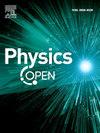用于储能应用的钆掺杂镍锌铁氧体的增强电学和磁性能
IF 1.4
Q2 Physics and Astronomy
引用次数: 0
摘要
采用柠檬酸盐凝胶自燃烧技术合成了钆(Gd3+)取代Ni0.8Zn0.2GdxFe2-xO4尖晶石铁素体(x = 0.00, 0.05, 0.10, 0.15, 0.20)。x射线衍射证实了立方尖晶石结构的形成,Gd3+取代后平均晶粒尺寸增大,而晶格参数呈减小趋势。场发射扫描电子显微镜显示颗粒凝聚,分散均匀,晶粒尺寸因掺杂而减小。能量色散x射线光谱证实了预期元素的存在。傅里叶变换红外光谱鉴定了四面体和八面体振动键ν1和ν2,并由此确定了力常数KT和KO。在室温下进行了介电常数、介电损耗和交流电导率等电学测量,结果表明,随着Gd3+含量的增加,电导率呈下降趋势。磁性表征表明饱和磁化强度降低,矫顽力增加。在Ni-Zn铁氧体中掺入Gd3+对合成材料的电学和磁学性能均有显著影响。适用于通信和储能系统。本文章由计算机程序翻译,如有差异,请以英文原文为准。
Enhanced electrical and magnetic properties of Gd-doped Ni-Zn ferrites for energy storage applications
Gadolinium (Gd3+)-substituted Ni0.8Zn0.2GdxFe2-xO4 spinel ferrites (x = 0.00, 0.05, 0.10, 0.15, 0.20) were synthesized using the citrate-gel auto-combustion technique. X-ray diffraction confirmed the formation of a cubic spinel structure, with an increase in average crystallite size upon Gd3+ substitution, while the lattice parameter showed a decreasing trend. Field emission scanning electron microscopy revealed agglomerated particles with homogeneous dispersion, and a reduction in grain size due to doping. Energy dispersive X-ray spectroscopy confirmed the presence of the expected elements. Fourier-transform infrared spectroscopy identified tetrahedral and octahedral vibrational bonds (ν1 and ν2), from which the force constants (KT and KO) were determined. Electrical measurements, including dielectric constant, dielectric loss, and AC conductivity, were conducted at room temperature, showing a decreasing trend with increasing Gd3+ content. Magnetic characterization indicated a reduction in saturation magnetization and an increase in coercivity. The incorporation of Gd3+ into Ni-Zn ferrites notably influenced both the electrical and magnetic properties of the synthesized materials. Which are suitable for communication and energy storage systems.
求助全文
通过发布文献求助,成功后即可免费获取论文全文。
去求助
来源期刊

Physics Open
Physics and Astronomy-Physics and Astronomy (all)
CiteScore
3.20
自引率
0.00%
发文量
19
审稿时长
9 weeks
 求助内容:
求助内容: 应助结果提醒方式:
应助结果提醒方式:


